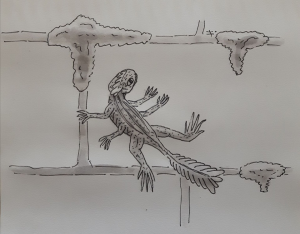Difference between revisions of "Peeper"
From World of Entorais Wiki
Jump to navigationJump to search (file) |
(→Description: content) |
||
| Line 6: | Line 6: | ||
==Description== | ==Description== | ||
;Classification: | ;Classification:Reptile | ||
;Size: | ;Size: Varies significantly between sub-species, generally less than 15 cm (6 inches) in total body length. | ||
;Appearance: | ;Appearance: Peepers in general are slim-bodied, with wedge shaped heads on short necks, six equal length limbs, and long slender tails. They are covered in small scales, and have a wide range of colours and patterns. | ||
;Sexual | ;Sexual Dimorphism: Common differences between the sexes of a species are colours and patterning being muted in females. Male often have more pronounced crests, pouches, frills or other additional features usually used in mate attraction and dominance displays. | ||
;Variance: | ;Variance:Individual species are usually marked with some distinct feature that sets them apart from the general norm, such as variations in tail shape, additional morphology, unusual colouration or other details. | ||
==Ecology== | ==Ecology== | ||
Revision as of 15:02, 14 March 2020
About
- Tiny lizards capable of emitting remarkably loud vocalizations. A variety of distinctive chirping, warbles, and whistles make up the various songs of these small critters. Most active at dawn and dusk, peepers are insectivores. Great variety in colouration and patterns exist amongst the species of these reptiles.
- Peepers are small lizards which come in a wide variety of sub-species with different habitats, activity cycles and myriad songs or mating calls. Some larger specimens have reportedly been taught to mimic speech.
- Common Names
- Peepers, Song-Lizards
Description
- Classification
- Reptile
- Size
- Varies significantly between sub-species, generally less than 15 cm (6 inches) in total body length.
- Appearance
- Peepers in general are slim-bodied, with wedge shaped heads on short necks, six equal length limbs, and long slender tails. They are covered in small scales, and have a wide range of colours and patterns.
- Sexual Dimorphism
- Common differences between the sexes of a species are colours and patterning being muted in females. Male often have more pronounced crests, pouches, frills or other additional features usually used in mate attraction and dominance displays.
- Variance
- Individual species are usually marked with some distinct feature that sets them apart from the general norm, such as variations in tail shape, additional morphology, unusual colouration or other details.
Ecology
- Habitat
- <--primary and secondary climate and terrain-->
- Diet
- Omnivorous, Eating a variety of plant materials, fruits, nuts, seeds, other smaller animals, insects, and worms.
Behaviour
- Social grouping
- <--herds, pack, solitary, etc-->
- Temperament
- inquisitive, and approachable, but will flee from sudden or aggressive actions
- Intelligence
- clever animals, some sub-species are capable of learning simple tricks, basic tool use, and mimicry.
- Reproduction
- <--method, cycles, associated behaviours-->
Sub-Species
Blue-Twin-crest
Noted for their pair of bright blue cockscomb crests which adorn the tops of their heads.
Domestication
- General
- Easily domesticated as pets, for entertaining songs, or limited vermin control.
- As food
- Too small for any large scale farming, peepers are sometimes considered a delicacy by gourmands.
Stories
See Also
<--links to related material-->
